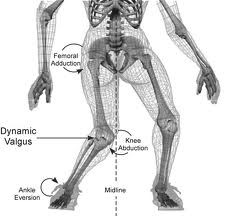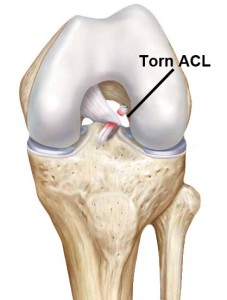Anterior Cruciate Ligament (ACL) Rupture
What is it?
An ACL rupture refers to a complete tear of this ligament inside the knee joint.
The ACL is most commonly injured when the knee twists when the foot is planted. This can occur when landing from a jump, pivoting or stopping suddenly when running. It can also occur from impact to the knee.
It can be surprising how relatively simple activities injure the ACL. It is not the strength of the load that is the main factor in causing injury, but the direction of the force involved. The most common direction of movement that results in ACL injury is where the knee buckles inwards with a degree of rotation.
How does it feel?
When the ACL is torn, there is often a loud ‘pop’, ‘crack’ or feeling of something ‘going out and then going back in’. When the ACL is completely torn, you may experience extreme pain for the first few minutes after the injury. Even though the pain may subside quickly, you will usually be unable to continue participating in activity because the knee may feel ‘unstable’ or collapse when you try to run or twist on the knee. Following an ACL rupture the knee usually swells very quickly, however this can develop over a 24 hour period.
To limit the severity of the symptoms it is advised that you stop your activity immediately and start initial treatment. The most important time in the treatment of any injury is the first 24-48 hours. Swelling is a necessary step in the healing process; however too much swelling can delay healing and cause further tissue damage. To control the amount of swelling and limit the degree of damage to the knee, the RICE regime should be followed.
Rest involves ceasing your activity or sport, and limiting the amount of weight you put through the leg. Crutches may be required if you are having difficulty walking.
Ice should be applied to the injured area for 10-15 minutes every couple of hours. ( **Please take care when icing the area as ice can burn**)
Compression involves the application of a firm elastic bandage (such as a tubigrip or cohesive bandage) starting from the lower of the calf and extending up to the top of the thigh. It should be firm but not tight enough to cause increased pain.
Elevation involves lying with your knee resting comfortably on a chair or pillows so that it is above the level of your heart.
You should continue with the RICE regime until you consult with a musculoskeletal health professional (i.e. physiotherapist, sports doctor, orthopaedic surgeon), preferably within 2 days of the initial injury.
What shouldn’t you do?
If you suspect you have injured your ACL, you shouldn’t ignore the problem and you certainly shouldn’t continue to participate in sports or exercise. This may cause your knee to give-way or collapse, potentially injuring other structures. In addition, you shouldn’t undertake activities which increase blood flow to the injured knee. These include hot showers, using heat rubs, consuming alcohol and excessive activity. Increased bleeding and swelling around the injured ligament may potentially prolong your recovery.
Could there be any long-term effects?
Unfortunately, an ACL rupture often results in prolonged recovery, and is the most common cause of prolonged absence from sport. Two reasons for this are that the ACL does not heal by itself and that the knee cannot function particularly well without this ligament. Surgery is usually required to repair or ‘reconstruct’ the ACL. During surgery, tissue from another part of your body may be used to replace or reconstruct the ACL. However some recent developments in surgical technique may allow the injured ACL to be repaired without taking a graft from other body sites. Following surgery, rehabilitation and return to previous activities may take up to 12 months depending on what activities you are returning to. Recovery time can be dependent on whether you injure other structures at the same time as the ACL injury. Other structures that may be injured could include cartilage and other knee ligaments.
Management
The assistance of a musculoskeletal health professional is important in the treatment of an ACL rupture. Initially, they can assist in the diagnosis of the problem and establishing its severity and determine whether you need surgery. An appropriate health professional will be able to assist you in returning to your job, activity or sport through appropriate treatment and rehabilitation. Good rehabilitation is the most important part of your recovery from an ACL rupture. Even if surgery is undertaken, the outcome of the surgery is only as good as the rehabilitation followed so working closely with a physiotherapist and working vigilantly on your rehabilitation program is crucial.
Disclaimer: This information is not a substitute for medical advice and you should seek professional advice from a doctor, physiotherapist or other healthcare professional.







